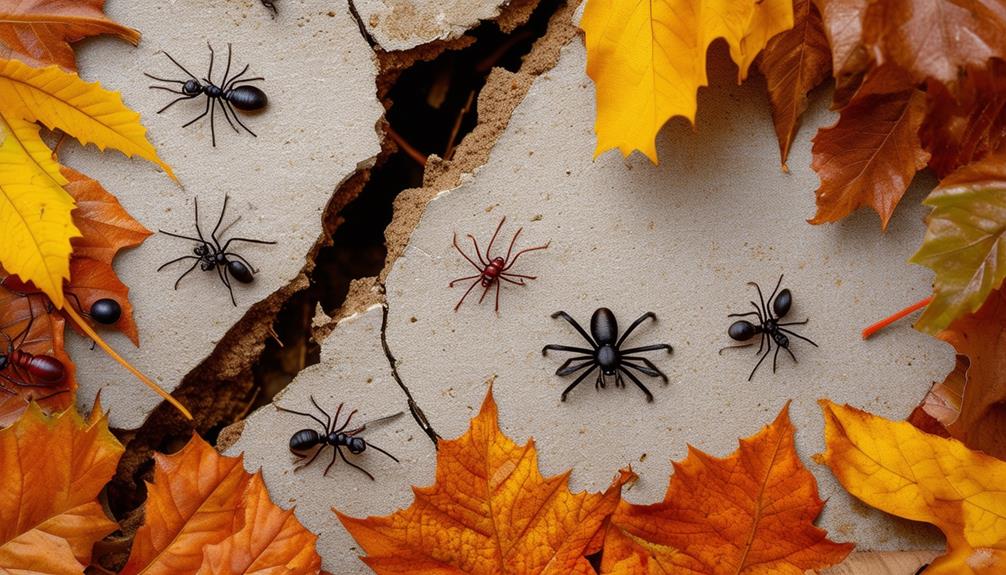When it comes to safeguarding your stored food from unwanted pests, a few key practices can make all the difference. Implementing proper storage methods is paramount to maintaining the quality and safety of your food supply. By taking simple yet effective steps, you can create an environment that deters pests and guarantees the longevity of your provisions. So, how can you guarantee that your food storage area remains pest-free and your supplies pristine?
Key Takeaways
- Use airtight containers to maintain food freshness and prevent contamination.
- Store food off the ground to minimize contact with pests and prevent contamination.
- Regularly clean storage areas to prevent infestations and maintain hygiene.
- Ensure proper ventilation to deter pests attracted to moisture and odors.
- Separate raw meats from ready-to-eat foods to prevent cross-contamination and pest attraction.
Importance of Proper Food Storage
Proper food storage plays an essential role in safeguarding your food from pests and maintaining its quality and safety. When it comes to food safety, storing items correctly is vital. By utilizing airtight containers, refrigeration, and proper labeling, you can deter pests and guarantee that your food remains safe for consumption. Following storage guidelines for different food types is essential. For instance, separating raw meats from ready-to-eat foods helps prevent cross-contamination and reduces the risk of attracting pests. Ensuring that your storage areas are clean and organized also discourages infestations in your pantry or kitchen.
Maintaining food quality and preventing spoilage are additional benefits of proper food storage practices. By keeping food items in sealed containers and following recommended storage methods, you can extend the shelf life of your groceries and avoid unnecessary waste. Remember, paying attention to detail in how you store your food can go a long way in ensuring its freshness and safety for you and your family.
Sealed Containers for Food Preservation
When it comes to storing food to prevent pests, sealed containers are your best friend. These airtight containers effectively maintain food freshness by keeping pests at bay.
Make sure to choose containers with secure lids to prevent any unwanted infestations.
Airtight for Freshness
To maintain the freshness of your stored food and prevent pest contamination, using airtight containers is essential. Airtight containers play an important role in preserving food quality by preventing exposure to air and moisture, reducing the risk of pests accessing and contaminating your stored goods. Options like mason jars and resealable containers are effective in deterring pests like insects and rodents. Here is a breakdown of why airtight containers are essential for food preservation:
| Benefits of Airtight Containers | Description | Examples |
|---|---|---|
| Maintain freshness | Prevents exposure to air and moisture | Mason jars, resealable bags |
| Prevent contamination | Preserves food quality and keeps pests away | Plastic containers, glass jars |
| Reduce pest risk | Minimizes the chances of pests contaminating stored food | Airtight canisters, vacuum sealers |
Secure Lids Prevent Infestation
Using sealed containers with secure lids is essential for preventing infestation and preserving the freshness and quality of stored food. Properly sealed containers offer several benefits:
- Preventing Pest Infestation: Secure lids keep pests like ants, roaches, and rodents away from stored food.
- Maintaining Freshness: Sealed containers help retain the aroma and quality of food by preventing exposure to external elements.
- Preventing Contamination: Secure lids reduce the risk of contamination, mold growth, and spoilage in stored food items.
- Ensuring Food Safety: Containers with secure lids maintain food safety standards by keeping pests out and maintaining hygiene in storage areas.
Container Shapes for Storage
For effective food preservation and pest prevention, selecting the appropriate container shape is essential to optimize storage space and maintain food quality. Sealed storage containers with airtight lids play an important role in preventing pest infestation and extending the shelf life of food items.
When choosing storage containers, consider options like jars, bins, and boxes, which offer versatility for storing different types of food. Square or rectangular containers are excellent choices for maximizing space efficiency in pantries and refrigerators. Round containers, on the other hand, are best suited for liquids, sauces, and soups due to their shape and easy pouring capabilities.
Additionally, stackable containers are practical for saving space and organizing various food items effectively. Selecting the right container shape can make a significant difference in keeping your food fresh and free from pests.
Elevated Storage to Prevent Contamination
Elevating your food storage containers is a practical strategy for preventing contamination and safeguarding your stored food items from potential pest access. When you elevate your food storage, you create a barrier that deters pests from reaching your food sources, thereby reducing the risk of infestation and preserving the hygiene of your stored items.
Here are some key benefits of elevated storage:
- Keeping food off the ground or low surfaces minimizes contact with pests like rodents and insects.
- Elevated storage of food helps prevent contamination by reducing the risk of pests accessing the food.
- Elevated shelving or storage racks provide a physical barrier between pests and stored food items.
- Elevating food storage containers can help maintain cleanliness and hygiene by avoiding contact with potential contaminants.
Regular Cleaning and Inspection Routine
To maintain a pest-free food storage environment, establishing a regular cleaning and inspection routine is essential to prevent infestations and guarantee the hygiene of your stored items. Implementing a consistent cleaning schedule helps prevent food debris buildup that attracts pests.
Regularly inspect food storage areas for any signs of pest activity such as droppings or gnaw marks, as early detection can prevent pests from getting comfortable in your storage spaces. Promptly clean up spills to eliminate potential food sources for pests and to deter infestations. Utilize a flashlight to thoroughly inspect dark corners and hidden areas where pests might hide, ensuring no spot is overlooked.
Additionally, consider using pest monitoring devices to detect early signs of pest presence in storage areas, aiding in the prevention of full-blown infestations. By following these steps diligently, you can maintain a clean and pest-free storage environment for your food items.
Maintaining Well-Ventilated Storage Areas
Proper ventilation plays a crucial role in keeping your food storage areas pest-free. By allowing for good airflow, you can prevent moisture buildup that attracts pests like mold and insects.
Ensuring your storage spaces are well-ventilated helps maintain ideal conditions for food storage and discourages pest infestations.
Air Circulation Importance
Ensuring adequate air circulation in your storage areas is essential for maintaining ideal conditions that deter pests and preserve the quality of stored food items. Proper airflow plays an important role in creating an environment that’s unfavorable for pests to thrive.
Here are some key points to keep in mind:
- Preventing Moisture Buildup: Good air circulation helps reduce the risk of mold growth by minimizing moisture levels.
- Pest Deterrent: Well-ventilated spaces discourage pantry moths and other pests by making it harder for them to survive.
- Temperature Regulation: Adequate airflow assists in maintaining consistent temperatures, which is essential for food preservation.
- Odor Control: Proper ventilation prevents the accumulation of odors that can attract pests seeking food sources.
Prevent Moisture Buildup
Maintaining a well-ventilated storage area is key to preventing moisture buildup and deterring pests from invading your food storage spaces. Essential ventilation plays a vital role in keeping humidity levels under control, reducing the risk of attracting pests.
Moist conditions can foster mold growth, which in turn, attracts insects and rodents seeking sources of food. By ensuring good airflow within storage areas, you can help create a dry environment that pests find less appealing.
Implementing ventilation systems or utilizing dehumidifiers are effective strategies to prevent moisture accumulation and consequently, pest infestations. Remember, controlling moisture levels through adequate ventilation is a proactive measure in safeguarding your stored food from pest-related issues.
Ventilation Reduces Pests
Implementing effective ventilation practices in your storage areas is crucial for reducing pests by controlling moisture levels and creating an inhospitable environment for unwanted invaders. Properly ventilated storage spaces offer several benefits in the fight against pests:
- Well-ventilated storage areas help reduce moisture, deterring pests like ants and cockroaches.
- Adequate ventilation prevents odors from building up, which can attract pests to stored food items.
- Good airflow discourages the growth of mold and mildew, which are attractive to pests.
- Proper ventilation helps maintain best temperature and humidity levels, making the environment less favorable for pests.
Prevention of Pest Attraction With Cleanliness
To prevent pests from being attracted to your food storage areas, prioritize cleanliness by regularly cleaning and removing food residues. Proper sanitation practices play a critical role in deterring pests from infesting your storage spaces. By maintaining cleanliness in your pantries and storage containers, you greatly reduce the chances of pests accessing your stored food. Spills should be promptly cleaned up, as keeping storage areas clean and free of any food debris minimizes the risk of pest infestation.
Regularly inspecting your food storage areas for any signs of pests or infestation is also essential. By staying vigilant and addressing any issues promptly, you can prevent pests from being attracted to your stored food. Additionally, organizing your storage containers and keeping food items tightly sealed can help prevent pests from gaining access to your provisions.
Frequently Asked Questions
How to Store Food to Avoid Pests?
When storing food to avoid pests, remember to use airtight containers like mason jars. This simple step can deter bugs and rodents from infiltrating your food supply. Keep those critters at bay with smart storage choices.
What Is the Best Way to Prevent Pest Infestation Food Safety?
To prevent pest infestation and maintain food safety, store items in airtight containers, refrigerate high-risk foods, and separate raw from cooked items. Check expiration dates regularly, discard expired foods, and use strong, non-toxic containers with tight lids.
What Are the Good Practices for Storage of Food Items?
When it comes to storage organization, you want to guarantee your food items are well-protected. Airtight containers are a must to keep pests away. Clear containers in the fridge can be your best allies in this battle.
Which Is the Best Method in Controlling Storage Pest?
When it comes to controlling storage pests, the best method is using airtight containers. These containers prevent pests from accessing your food sources, effectively keeping them at bay. Make sure to seal your food items properly!




